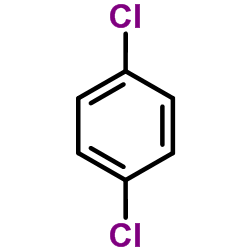1,4-Dichlorobenzene

1,4-Dichlorobenzene structure
|
Common Name | 1,4-Dichlorobenzene | ||
|---|---|---|---|---|
| CAS Number | 106-46-7 | Molecular Weight | 147.002 | |
| Density | 1.3±0.1 g/cm3 | Boiling Point | 174.1±0.0 °C at 760 mmHg | |
| Molecular Formula | C6H4Cl2 | Melting Point | 52-54 °C(lit.) | |
| MSDS | Chinese USA | Flash Point | 65.6±0.0 °C | |
| Symbol |



GHS07, GHS08, GHS09 |
Signal Word | Warning | |
|
Developing structure-activity relationships for the prediction of hepatotoxicity.
Chem. Res. Toxicol. 23 , 1215-22, (2010) Drug-induced liver injury is a major issue of concern and has led to the withdrawal of a significant number of marketed drugs. An understanding of structure-activity relationships (SARs) of chemicals can make a significant contribution to the identification o... |
|
|
A predictive ligand-based Bayesian model for human drug-induced liver injury.
Drug Metab. Dispos. 38 , 2302-8, (2010) Drug-induced liver injury (DILI) is one of the most important reasons for drug development failure at both preapproval and postapproval stages. There has been increased interest in developing predictive in vivo, in vitro, and in silico models to identify comp... |
|
|
QSPR modeling of octanol/water partition coefficient for vitamins by optimal descriptors calculated with SMILES.
Eur. J. Med. Chem. 43 , 714-40, (2008) Simplified molecular input line entry system (SMILES) has been utilized in constructing quantitative structure-property relationships (QSPR) for octanol/water partition coefficient of vitamins and organic compounds of different classes by optimal descriptors.... |
|
|
Development of QSAR models for predicting hepatocarcinogenic toxicity of chemicals.
Eur. J. Med. Chem. 44 , 3658-64, (2009) A dataset comprising 55 chemicals with hepatocarcinogenic potency indices was collected from the Carcinogenic Potency Database with the aim of developing QSAR models enabling prediction of the above unwanted property for New Chemical Entities. The dataset was... |
|
|
Caffeine in surface and wastewaters in Barbados, West Indies.
Springerplus 4 , 57, (2015) Caffeine, a purine alkaloid drug, has been recognized as a contaminant of water bodies in various climatic regions, however, these environmental caffeine concentrations are the first to be reported in the tropical Caribbean. The major objective of this study ... |
|
|
Quantitative structure-activity relationship and complex network approach to monoamine oxidase A and B inhibitors.
J. Med. Chem. 51 , 6740-51, (2008) The work provides a new model for the prediction of the MAO-A and -B inhibitor activity by the use of combined complex networks and QSAR methodologies. On the basis of the obtained model, we prepared and assayed 33 coumarin derivatives, and the theoretical pr... |
|
|
The nongenotoxic carcinogens naphthalene and para-dichlorobenzene suppress apoptosis in Caenorhabditis elegans.
Nat. Chem. Biol. 2 , 338-45, (2006) Naphthalene (1) and para-dichlorobenzene (PDCB, 2), which are widely used as moth repellents and air fresheners, cause cancer in rodents and are potential human carcinogens. However, their mechanisms of action remain unclear. Here we describe a novel method f... |
|
|
Permeable reactive barrier of coarse sand-supported zero valent iron for the removal of 2,4-dichlorophenol in groundwater.
Environ. Sci. Pollut. Res. Int. 22 , 16889-96, (2015) In this study, coarse sand-supported zero valent iron (ZVI) composite was synthesized by adding sodium alginate to immobilize. Composite was detected by scanning electron microscope (SEM), X-ray diffraction (XRD), and X-ray fluorescence (XRF). SEM results sho... |
|
|
Quantitative structure-activity relationship analysis of inhibitors of the nicotine metabolizing CYP2A6 enzyme.
J. Med. Chem. 48 , 440-9, (2005) The purpose of this study was to develop screening and in silico modeling methods to obtain accurate information on the active center of CYP2A6, a nicotine oxidizing enzyme. The inhibitory potencies of 26 naphthalene and 16 non-naphthalene derivatives were de... |
|
|
Exploring QSAR and QAAR for inhibitors of cytochrome P450 2A6 and 2A5 enzymes using GFA and G/PLS techniques
Eur. J. Med. Chem. 44 , 1941-51, (2009) A series of naphthalene and non-naphthalene derivatives ( n = 42) having cytochrome P450 2A6 and 2A5 inhibitory activities, reported by Rahnasto et al., were subjected to QSAR and QAAR studies. The analyses were performed using electronic, spatial, shape and ... |